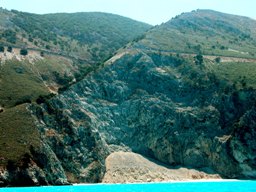
Slope failure
Triggered by powerful earthquakes, Thinia valley’s unstable eastern slopes often generate rock avalanches today and there is clear field evidence for major rockfalls and landslides in this area. Widespread boulder-strewn slopes are common, many involving high-volume mass wastage in which large sections of the mountainside have detached from underlying strata during the late Holocene.
Figure 4 is a satellite image of the isthmus in which the blue lines indicate unstable hillslope edges. Yellow and green lines show the most likely eastern and western boundaries for any buried channel, based on serial cross-sections, slope geometry and an extensive surface survey. The location of the narrow southern end of this potential channel route is closely constrained by the adjacent limestone strata, but the surface geology of the much wider northern segment at present suggests several possible channel routes for geoscientific evaluation.
Several spectacular examples of collapse characterise the coastline to the north of Thinia (Figures 5a & b). The photograph in 5a shows a large, unstable detached (olistolith) block on the eastern cliff of Myrtos Bay. The car highlighted for scale gives some idea of the mass involved. Figure 5b shows how contemporary cliff failure has narrowly avoided destroying the coast road. Much of the debris from this fall has already been washed out to sea here because the base of the cliff is unconfined.
The landscape on the eastern side of the Thinia valley consists mainly of loose, pulverised debris that has descended catastrophically from the mountains above. A major, isolated westerly-derived rockfall deposit also sits at the northerly end of the isthmus beneath the village of Zola. In several instances, extensive rockfall and landslide deposits have cut off roads and carried away houses (Figures 7 & 13).
Figure 6a shows the scale of the eastern mountain range above Nifi village. As well as the effects of high-altitude co-seismic hillslope failure, this village also suffers from local landslides which can take place without help from earthquakes in wet conditions. The last such event occurred in November 2007 and destroyed several houses (Figure 6b & c). Further to the south of the island, the August 1953 earthquake triggered several major cliff collapses
3.